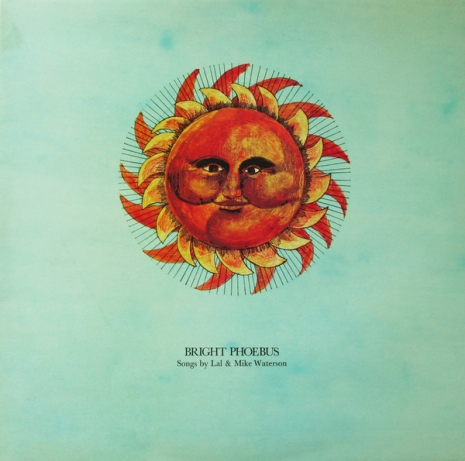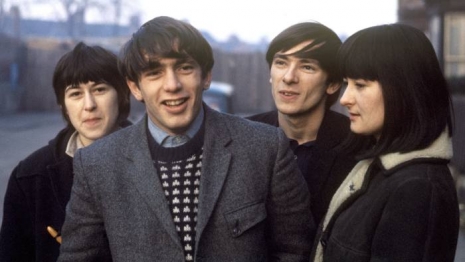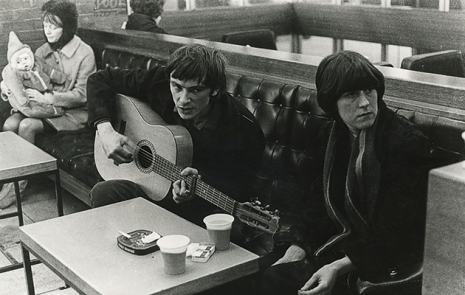Lal Waterson Once in a Blue Moon Rar
'Bright Phoebus': The stunning pagan Brit folk cult classic that you must hear before you die!*

*Sorry about the title, honest.
Despite the fact that I do tend to mostly post about music here, and that we are, editorially speaking, an outsider arts/music blog, of course, I do not, and never have considered myself a music journalist or like a "rock critic" or anything of the sort. We're seldom very "critical" of anything on this blog. Instead the idea is to write about topics that we're enthusiastic about. The philosophy more being "check out this hidden gem" and not "here this smells like shit, smell this." We endeavor to call your attention to the good stuff. Things that we love. We're fans, not critics.
I'm not really even sure that there is much room anymore for music criticism, that the time for it has passed. When all anyone has to do is dial up Spotify or YouTube and listen for themselves, there's not much need for a digital age Lester Bangs or Nick Kent to convince you to plunk down the cash for an album you had few ways of sampling before you bought, because you can hear everything. Instantly. You can just hit play and you're off to the races. My job is simply to get you to do just that: to write some words conveying my own enthusiasm for a given item that will then in turn convince you to HIT PLAY AND LISTEN. That's it. No more, no less, that's my only goal: "Check this out." There is an overwhelming amount of stuff. My job is to help.
But I also know from 23 years of Internet content creation that if 100,000 people read a given post, only between 1% and 3% will actually watch the associated videoclip. Even fewer will listen to an embedded sound file. So the "this sucks" approach clearly needs rethinking as it's simply self-defeating in a pageviews-seeking paradigm. The general public would like some help with sorting through the detritus of a century plus of pop culture, in a breezy, easily digestible context, not to step in something unpleasant. Still, very few of us ever play the media, the stats remain remarkably consistent.
But let me rein this in: If you tend to trust or agree with my musical enthusiasms as related on this blog, then pay close attention here and for sure, do not just take my word for it, press play and listen for yourself. Promise? You're gonna be glad that you did.

Lal Waterson, John Harrison, Mike Waterson and Norma Waterson
The Watersons were a mid-60s "traditional" English folk group. They consisted of three siblings—Norma, Lal and Mike Waterson, who had been orphaned and raised by their grandmother—and their cousin John Harrison. The Watersons were from Hull and sang traditional English folk songs, unpolished and a cappella. Once you have heard their very distinctive, weather-beaten voices singing together you would never mistake them for anyone else. Although their rough-hewn harmonies were considered the epitome of authenticity, they themselves never thought of themselves as such. A truly traditional British folk singer wouldn't have been singing in nightclubs, for instance, but singing as one did their farm chores or in church. They weren't precious or devout about themselves, no—and this they made clear in humble, self-aware interviews—but the music itself was treated with the utmost respect. The Watersons were extremely influential in mid-60s English folk circles (there was even a BBC documentary made about them in 1965) but by the end of the decade, tired of the grind of traveling around the country in a van they also often slept in and of performing for sustenance wages, Lal and Mike returned to civilian life, regular jobs and raising families while big sister Norma worked as a radio DJ in Montserrat.
By 1972 both Lal and Mike had amassed quite a catalog of original songs they'd demoed on a tape recorder at Lal's house. Steeleye Span's Martin Carthy visited Lal in Hull and she played him their tunes. Floored by what he'd heard, Carthy in turn played them for his bandmate Ashley Hutchings, who had formerly been in Fairport Convention. Hutchings felt similarly about the material and started the ball rolling, enlisting producer Bill Leader and his former Fairport bandmates Richard Thompson and Dave Mattacks to the task. A makeshift recording studio was set up in the basement of the Cecil Sharp House, the north London headquarters of the English Folk Dance and Song Society.
The result was Bright Phoebus, one of the most striking, starkly observed and oddly beautiful albums ever recorded.

Mike and Lal Waterson
The ill-fated history of Bright Phoebus is a story by now well known to British music fans: The reviews, when there were any, were not generally positive. How could the esteemed Watersons, the very exemplars of authenticity have anything to do with this weird, non-trad music? Not only were there musical instruments involved, some of them were even electric. And there were sound effects. The conservative English folk music scene (mostly) rejected the album, or paid it no mind. Further compounding the album's almost immediate obscurity was the fact that of the 2000 albums the record label had pressed, half had off center spindle holes drilled in them.
Over the years cassettes and CDrs of Bright Phoebus began to circulate, picking up fans like Jarvis Cocker, Richard Hawley, Fatima Mansions, Arcade Fire, Billy Bragg and others. From time to time one of the tracks might appear on a folk compilation, but the album was pretty much unavailable, with original copies selling for high prices. This was despite enough interest in the album that Lal and Mike Waterson tribute concerts (including Jarvis Cocker, younger Waterson family members, Norma and her husband Martin Carthy and others) were mounted, articles appeared in the Guardian about this unheard cult album, and there was even a Bright Phoebus BBC radio documentary. In 2017 Lal Waterson's daughter Marry and David Suff remastered the album from the original master tapes and Domino Records released the album four ways, as a single CD with just the original album, as a double CD that also included Lal and Mike's demo tapes and single and double vinyl versions.
When Bright Phoebus was reissued I asked for a review copy and although I liked it, it didn't exactly wow me at first. I probably played it twice before putting it away. I didn't stick it into the trade pile, but for 8-9 months I didn't reach for it again either. Then I reread Joe Boyd's book White Bicycles—in which Norma makes a brief appearance—and Electric Eden, Rob Young's encyclopedic history of English visionary folk which also mentions the Watersons, and Bright Phoebus in particular. I needed something to play in the car one day and decided to give Bright Phoebus another chance. I'm glad I did. By the end of my errands I was hooked on the album's singular beauty and it has become one of my top favorite albums. There's really nothing else like it.
I'm now somewhat of an evangelist for Bright Phoebus. As most Americans would have no affiliation to the Watersons, I've noticed that my impassioned ranting and raving about this British cult folk album with a strong whiff of The Wicker Man tended to provoke no reaction whatsoever until I mention Richard Thompson being all over Bright Phoebus and then the beneficiary of my rock snob wisdom tends to perk up. True, Thompson's involvement is reason enough for any serious music fan to be intrigued, but a comparison that might bridge the Anglo-American divide is to put Bright Phoebus in the same rarified uncategorizable category as The Basement Tapes, another singular collection of songs recorded by freaky folkie friends in a basement. Dylan and the Band were channeling the "old, weird America" in that Woodstock house, while a few years later the Watersons and their allies took the spirit of pagan campfire music and wedded it to a forward-thinking—alternately bone-chilling, sweet and sunny or emotionally devastating—British folk rock that took the world 45 years to catch up with.
Very simply summarized, the Waterson's music won't be for everyone reading this far, or even for everyone who takes me up on my advice and samples the album below. I know that will only be a small portion of you, but among that number—and yes, I am addressing YOU—expect to find something to obsess about for the rest of your life.
The glorious title track.
Lal's "The Scarecrow," sung by Mike. LISTEN very carefully to the lyrics the entire way through.
2007 BBC radio doc about the album by Pete Paphides, who has long championed 'Bright Phoebus,' and who wrote the excellent liner notes for the reissue release.
Norma, Mike and the Waterson Family sing "Bright Phoebus" at Hull Truck.
Full playlist here
"Hal-An-Tow" taken from the BBC TV documentary 'Travelling for a Living.'
Source: https://dangerousminds.net/comments/bright_phoebus_the_stunning_pagan_brit_folk_cult_classic_that_you_must_hear
0 Response to "Lal Waterson Once in a Blue Moon Rar"
Post a Comment